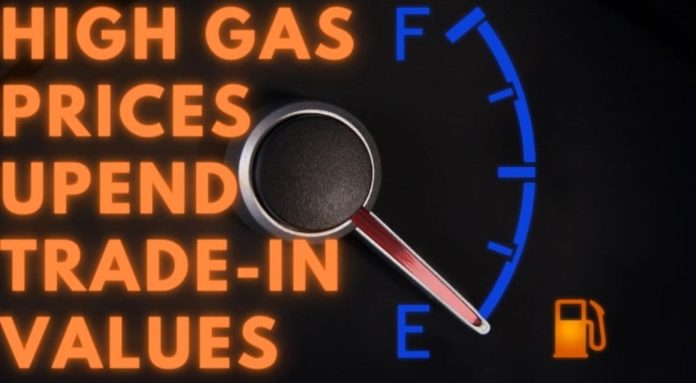Each year millions of drivers trade in an older vehicle to finance their next purchase. It’s a useful system, allowing drivers to make room in their budget––and garage––for a new vehicle, but the process has been turned on its head as of late. Trade-in values reached an all-time high during the last few years as supply chain issues, and computer chip shortages seized the industry, with the average used vehicle garnering more than $17,000. This was encouraging news for Erik Hanson, who figured trading in his old Toyota Corolla would go a long way in subsidizing the cost of a new 2022 Nissan Murano, but sadly, it wasn’t to be.
“The first question they asked me was how much gas it had in it, which I thought was kind of odd,” said Hanson. “When I told the salesman it was less than a quarter tank, he just shook his head and punched some numbers into his calculator.”
Hanson is one of many drivers who’ve failed to factor in historically high gas prices before going to sell their vehicle. With gas currently commanding well over the $100 per barrel mark, the amount of such liquid gold in the tank can be the difference between a quick trade-in and a disappointing ride home in your same old vehicle.
Hanson knew the Corolla wasn’t a collector’s item, but the offer still seemed appallingly low, especially considering the current lack of supply on the market. With his trade-in suddenly seeming almost worthless, Hanson had his own number-crunching to do. While he was anxiously Googling the sale price of various organs and eligibility requirements for medical studies, Hanson caught the eye of the salesman, who offered some sage advice.
“He said, ‘next time, fill it with gas first,’” says Hanson. “I hadn’t fueled up for a couple of weeks, so I had no idea what he was talking about, but as soon as I saw the prices at a couple gas stations on the way home, it all clicked.” The nation’s dealerships have quickly become wary of trade-ins with nearly empty tanks, making lowball offers, or just turning away customers who arrive cruising on fumes.
“It just destroys our margins,” says Chet Swanson, a salesman at Parkside Nissan. “Once we fill those puppies up and take a few test drives, we actually start losing money on each sale.” The team at Parkside has already developed a new code word to warn other salespeople about these gas-less wonders, according to Swanson. “We’ve started calling them ‘fossils’ because they’re bone dry,” he says.
Dealerships are now on the lookout as sellers become savvier about upping their trade-in’s curb appeal, ethically or otherwise. Swanson says that Parkside has seen all manner of automotive tomfoolery in recent weeks, including gas-powered vehicles altered to look like hybrids or EVs, as well as some questionable fuel substitutes.
“I was pretty sure that Buick didn’t have any EVs on the market yet, so I looked a little closer and realized that ‘Electric Vehicle’ had just been carved into the chassis with a penknife,” said Swanson. “I’ll admit that the guy with the fake fuel did almost fool me, but luckily I’m very familiar with the smell of Coors Light and am pretty sure that gasoline doesn’t usually have bubbles in it.”
An avowed fan of free-market economics, Swanson doesn’t see anything inherently wrong about the new trade-in approach, though he does recognize that it has gotten out of hand at times. The salesman recalls one incident where a driver attempted to trade in a 1997 Saturn Ion that was missing two hubcaps and a majority of its rear bumper. “Normally, we wouldn’t offer you a cup of our complimentary coffee for such a hunk of junk, but after we heard that sweet, sweet sloshing sound, we closed the deal and let the guy leave here in a new Titan,” he says.












